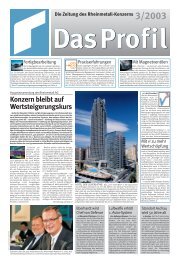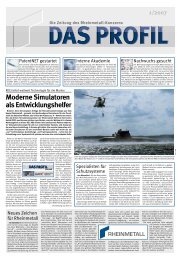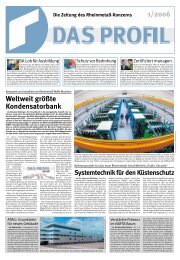PDF [2.5 MB] - Kolbenschmidt Pierburg AG
PDF [2.5 MB] - Kolbenschmidt Pierburg AG
PDF [2.5 MB] - Kolbenschmidt Pierburg AG
Create successful ePaper yourself
Turn your PDF publications into a flip-book with our unique Google optimized e-Paper software.
Newsline<br />
Naval school Mürwick uses new simulator generation<br />
Virtual seaways, fog on command<br />
Mürwick/Bremen. Maritime traffic is<br />
governed by a “right-of-way” just like<br />
other traffic. Anyone who fails to obey<br />
this has to expect serious damage to<br />
the crew and ship. Although mistakes<br />
made at the naval school in Mürwick<br />
may cause accidents, these are nevertheless<br />
without impact on man and<br />
machine as dangerous situations are<br />
all part of simulator training. The AANS<br />
shiphandling training system at the<br />
school’s simulation center has one fundamental<br />
objective: to train actions<br />
and reactions sufficiently to avoid<br />
errors and to teach trainees how to<br />
deal with mistakes made by others in<br />
order to avoid major damage. In addition<br />
to this, there are a whole lot of procedures<br />
that are important for naval<br />
forces and require initial training in the<br />
simulator. Nevertheless, simulator training<br />
is still only one (important) element<br />
of training since true seamanship<br />
can only be learned on board ship.<br />
After far more than 20,000 hours of<br />
operation of the old simulation center<br />
taken into service back in 1987, the<br />
decision in favor of a system renewal<br />
was reached in 1997. Two years of<br />
planning, development and integration<br />
by the Bremen-based company<br />
STN Atlas Elektronik GmbH then follo-<br />
wed this decision. The modernized simulation<br />
center was finally taken into<br />
operation on 2 December 1999. The<br />
gap between a simulator and the real<br />
ship is becoming smaller and smaller.<br />
The simulations provided by the new<br />
AANS at the naval school in Mürwick<br />
are so realistic that even experienced<br />
seafarers soon forget that they are<br />
“only” commanding a computer-generated<br />
simulation and not a real<br />
ship.<br />
The system is equipped with the very<br />
latest state of the art. It consists of a<br />
true-to-scale nautical bridge with all<br />
the usual instruments like control<br />
stand, engine console and radar<br />
equipment. An eleven-channel visual<br />
system with CGI (computer generated<br />
images) allows a realistic simulation<br />
of the outside world at day and night.<br />
Even complicated docking maneuvers<br />
can be practiced in the simulator<br />
thanks to the exact physical/mathematical<br />
reproduction of the own ship’s<br />
model, including the use of lines and<br />
pilot vessels.<br />
Two instructor stations as well as a<br />
briefing/debriefing room are available<br />
for control and monitoring purposes.<br />
The instructor communicates with his<br />
pupils via intercom and VHF. Besides<br />
Rheinmetall assigned“BBB/A-2”<br />
London/Düsseldorf. Standard &<br />
Poor’s recently assigned its triple-“B”<br />
long-term corporate credit and senior<br />
unsecured debt ratings, and its “A-2”<br />
short-term corporate credit ratings to<br />
the German group Rheinmetall <strong>AG</strong>.<br />
The outlook is stable.<br />
The ratings reflect Rheinmetall’s moderate<br />
financial profile and average<br />
business-risk profile, based on sound<br />
positions in its respective markets.<br />
These strengths are offset partly by<br />
exposure to the German defence sector<br />
(about 15% of sales are to the German<br />
defence ministry) and to market<br />
trends in the global automotive and<br />
electronics industries.<br />
A key rating factor is the company’s<br />
standing as market leader in several<br />
industrial segments that target different<br />
customer groups. In the defence<br />
sector, Rheinmetall further benefits<br />
from a comfortable order backlog. Also,<br />
the ratings take into account<br />
Rheinmetall’s moderate geographical<br />
diversification, to which Germany<br />
contributes about one-half of consolidated<br />
sales.<br />
In the past few years, Rheinmetall<br />
has grown very rapidly thanks to several<br />
substantial acquisitions. The<br />
group more than doubled its sales<br />
between 1997 and 1998. In the year to<br />
Dec. 31, 1998, the group generated revenues<br />
of euro (€) 4.13 billion (US$<br />
4.37 billion) and earnings before interest,<br />
taxes, depreciation, and amortisation<br />
(EBITDA) of € 328 million. The<br />
group’s lease-adjusted EBITDA margin<br />
has increased gradually over the<br />
years, and amounted to about 10% in<br />
1997 and 1998. The group posted a<br />
8<br />
The naval school at Marwick also uses<br />
the latest simulator generation from<br />
STN Atlas Elektronik GmbH.<br />
the bridge with visual system, the training<br />
system includes six cabins with<br />
the complete nautical equipment but<br />
without the visual systems.<br />
The interaction between the main<br />
bridge and cabins also allows exercises<br />
like nautical operations in units<br />
and combined operations with several<br />
ships. The general configuration therefore<br />
also meets the international standards<br />
for training nautical and technical<br />
officers of ships in accordance with<br />
STCW 95 (standards of training, certification<br />
and watchkeeping for seafarers,<br />
issued by the International<br />
Maritime Organisation IMO) which is<br />
obligatory for all UN members.<br />
pre-tax loss of € 17.7 million in the<br />
first half of 1999 (compared with a<br />
pre-tax profit of € 5.2 million in the<br />
first half of 1998), partly because of<br />
the fact that profits in engineering<br />
and defence activities are typically<br />
booked in the second half of the year,<br />
but also because of softer sales.<br />
With a lease-adjusted net debt-tototal<br />
capital ratio of 26% at Dec. 31,<br />
1998, Rheinmetall is considered to<br />
have good financial flexibility and a<br />
moderate financial policy.<br />
Standard & Poor’s expects the financial<br />
burden of future external growth<br />
to be alleviated partly by equity<br />
support from existing shareholders<br />
and/or strategic partners. The balance-sheet<br />
structure is expected to remain<br />
very conservative. The ratings<br />
do not assume any major improvement<br />
in profit margins, or any substantial<br />
organic growth, Standard &<br />
Poor’s said.


![PDF [2.5 MB] - Kolbenschmidt Pierburg AG](https://img.yumpu.com/8112793/8/500x640/pdf-25-mb-kolbenschmidt-pierburg-ag.jpg)
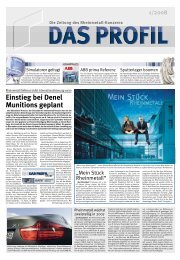



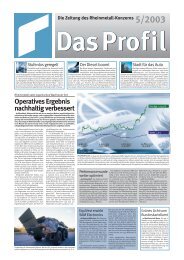
![PDF [1.6 MB] - Kolbenschmidt Pierburg AG](https://img.yumpu.com/8657804/1/171x260/pdf-16-mb-kolbenschmidt-pierburg-ag.jpg?quality=85)
![PDF [2.4 MB] - Kolbenschmidt Pierburg AG](https://img.yumpu.com/8295864/1/184x260/pdf-24-mb-kolbenschmidt-pierburg-ag.jpg?quality=85)




